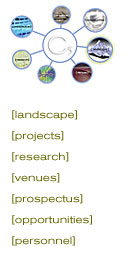 |
Permission
![]()
Lisa Jevbratt
In the pursuit of identifying and grasping concepts of networked space
within discourses of the internet, it is beneficial to examine the roles
that datum, agents (such as humans) and sub-networks can have within a
network. By creating new models for these roles we could not only gain an
understanding of networked space, but also be able to understand how and
when art occurs in a network and to form an adequate critique of this art.
Existing models for these roles builds on post-structuralist theory about
signification processes and concepts of the wreader in hypertext
theory. Datum in these models exists in a sign/signified dichotomy where a
datum have the ability of either being referred to by other data, or
referring to other data, a datum is either a sign of something (language)
or something that can be signified (reality). An agent in these models
exists on a reader -- writer continuum. In hypertext theory this role is
sometimes called wreader to indicate the merging of the reader and writer
roles. Roland Barthes explores the same continuum when he in "The Death of
the Author" gives the reader the unifying role. A text's "unity" lies not
in its origin, the author, but in its destination, the reader.
The model that is briefly introduced here builds on ideas of
social interaction and relations instead of the active vs. passive
construct in the sign/signifier dichotomy or the producer -- consumer
continuum of hypertext theory.
Each entity in a network (datum, agent or sub-network etc. ) can be
described as a mingler. At any given point in time, the mingler
exists on a continuum of three categories. Those three categories are
the inviter (the Host), the invitee (the guest) and the
non-invitee (the parasite). In the inviter category we could find
an internet service provider, a specific computer, server software, a web
site, a web designer and a datum. In the invitee category we could find an
HTML page, a visitor of a web site, or a datum. In the non-invitee
category we could find "bots", viruses, errors, glitches, hackers and a
datum. The minglers socialize with each other in a continuous exchange.
The guest is part of the expected audience, which are given certain
permissions in terms of access and interpretation. There is an agreement
set up between the host and the guest, and there is an important element
of trust in their relationship. The parasite is not explicitly considered
by the host as a receiver, and the information is thus not targeted to
accommodate the parasite.
Each mingler category comes with a default set of permissions, but
also with a certain ability to change those. Permission categories are not
parallel to mingler categories. A mingler has the possibility of
addressing minglers, being addressed by minglers and acting upon minglers.
It can hold any of these abilities at the same time and it can change its
permissions depending on its current mingler category and permission
setting. The mingler is not a static entity with a linguistic dynamic
relationship to another mingler, but is in itself dynamic in its ability to
directly address or be addressed. The relationship between minglers is
thus not a reflection on their ontology (as in a reality vs.
simulation/language construct), but a reflection on an agreement between
the minglers. A mingler can choose to give access to one mingler, but not
to another. A group/set of minglers can invite another group/set of
minglers to cause action, while being invited to cause action in a third
group/set of minglers. The relationship between minglers are rarely
symmetric and mostly multi-directional. Therefore it would be interesting
to consider concepts such as trust, secrecy and initiation in the
examination of behavior and roles of datum and agents in networks.
Network art occurs in a complex interplay of mingler types and
permissions. The art work is constantly moving along the inviter -- invitee
-- non-invitee continuum and it manipulates permissions. Its roles and
interpretations can not be defined along a reader -- writer continuum or
by a sign/signified dichotomy. The C5 Sixteen Sessions project is
explicitly playing with invitational structures and permissions in a quest
for its ontological status as art. Data describing a physical space is
invited to mingle with network data. Through this process, access to
information pointing to web servers is provided to the user. Servers which
often are, because of their permission settings, inaccessible for the
user. In the semantic environment constituted by the gap between the
network map of the IP database and the data describing a physical space, a
collapse of the sign/signified dichotomy occurs and the resulting void
invites us to non-inviting space in an infinite recursion. The project
becomes a guest in the network, gleefully putting a stone in the door to
let the non-invited in. Wandering between its roles keeps it wondering.
This curse of the art work, to repeatedly ask about its ontological
status, constitutes its means for communication, it is how it says
anything about anything.